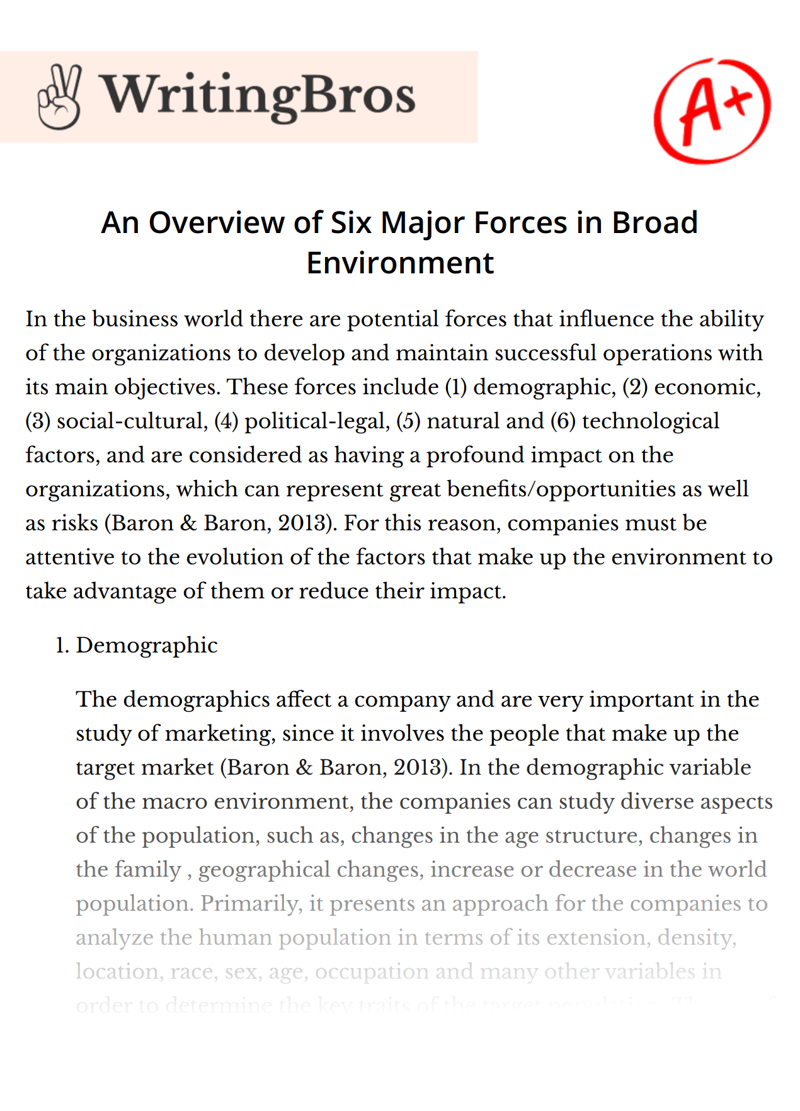An Overview of Six Major Forces in Broad Environment

In the business world there are potential forces that influence the ability of the organizations to develop and maintain successful operations with its main objectives. These forces include (1) demographic, (2) economic, (3) social-cultural, (4) political-legal, (5) natural and (6) technological factors, and are considered as having a profound impact on the organizations, which can represent great benefits/opportunities as well as risks (Baron & Baron, 2013). For this reason, companies must be attentive to the evolution of the factors that make up the environment to take advantage of them or reduce their impact.
- Demographic
- Economic
- Social-Cultural
- Natural
- Technological
- Political-Legal
The demographics affect a company and are very important in the study of marketing, since it involves the people that make up the target market (Baron & Baron, 2013). In the demographic variable of the macro environment, the companies can study diverse aspects of the population, such as, changes in the age structure, changes in the family , geographical changes, increase or decrease in the world population. Primarily, it presents an approach for the companies to analyze the human population in terms of its extension, density, location, race, sex, age, occupation and many other variables in order to determine the key traits of the target population. The set of identified traits are later utilized for the determination of preferences regarding the consumer behavior and products required (Falkner, 2017). Most companies locate and identify their primary consumers through the assessment and utilize these characteristics in their promotions and advertisements to boost the profits or sales of the company.
The macro-economic environment around the organization is a key factor that influences the organizational microeconomics. A decrease in interest rates can be an incentive to finance assets and increase-installed capacity (Zinovieva et al. , 2016). During a recession, consumers tend to spend less for unnecessary products for example appliance or a car. As a result sellers in this line of business will see a drastic decrease in sales. On the other hand, if the regional economy is prosperous then the consumers are likely to spend, and buy luxury items (Falkner, 2017).
The social factors that affect the monetary environment of the organization include the cultural factors, such as trends in consumption, fashions and customs (Leonidou et al. , 2017). The consumerist tendencies are easily transferable in certain cultures, so for example technological advances from Asia or the United States, are easily accepted in Western Europe and Latin America. The same does not happen in social environments that tend to be more orthodox or conservative, such as the Middle East and Eastern Europe, where styles that seem to be fashionable are not easily accepted as a fashion trend. Also, one must be conscious when hiring personnel, their cultural and social system must be taken into account (Falkner, 2017)
Nature has influence on business, in some cases it dictates where and how certain activities can be conducted. In this context, awareness is key. It helps businesses understand the environment and manage their operations effectively. An example is knowing how a service or product is to be delivered or how these may be or are damaging to the environment. Also, the increase of sea levels, tornadoes, hurricanes or earthquake prone regions force companies to change their geographical locations (Smith, 2016).
Technology and innovation affect businesses and operations. To stay competitive, a company must be up to date with the fast growing technology. Companies that do not stay abreast with technological advancement usually encounter higher risks for cost of production and will lose market competitiveness (Falkner, 2017; Leonidou et al. , 2017). For Lenonidou et al. , (2017), technological advancements help companies and executives handle the organizational processes in a much effective manner.
The political environment unavoidably affects the economic performance of companies, they may either present opportunities or a threat. Legislators at the federal, state or local levels on the one hand can offer incentives or tax or tariff exemptions to companies. They can also impose rules that restrict or limit their business transactions (Baron & Baron, 2013). A change in foreign trade policies may affect the cost structure of imported raw materials, importers or exporters of finished products. Companies, in order to maintain their equilibrium, must add those impacts in costs to the prices of their products, thereby making the customers pay a higher price for their products. The consumer must then decide whether or not to buy the specific product. If the product has an elastic demand, sales will drop which will affect the company. An imminent decision in a situation like this is to reduce labor costs by laying off employees. The legal norms, or regulations, etc. also have significant impact on an organizations. For examples are minimum wage fixed, tax rates or environmental standards influence investment decisions and companies' costs (Baron & Baron, 2013).
Cite this Essay
To export a reference to this article please select a referencing style below

